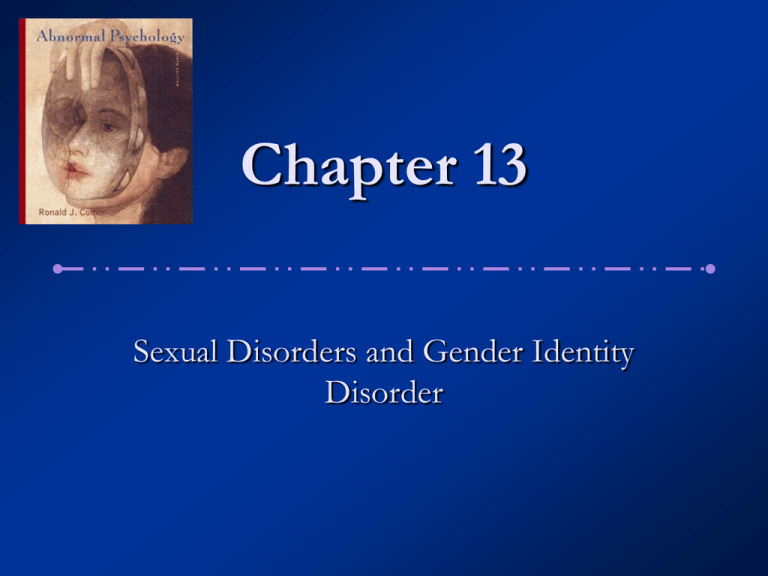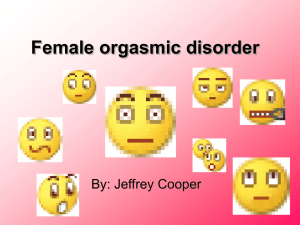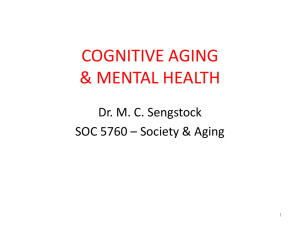
Chapter 13
Sexual Disorders and Gender Identity
Disorder
Categories of Sexual Disorders
Sexual Dysfunctions
Paraphilias
People who experience problems with their sexual responses
People with repeated intense sexual urges or fantasies in
response to objects or situations that society deems
inappropriate
Gender Identity Disorder
A sex-related disorder in which people persistently feel that
they have been assigned to the wrong sex and identify with
the other gender
Sexual Dysfunctions
Sexual dysfunctions are disorders in which people cannot
respond normally in key areas of sexual functioning
As many as 31% of men and 43% of women in the U.S. suffer
from such a dysfunction during their lives
Sexual dysfunctions are typically very distressing, and
often lead to sexual frustration, guilt, loss of self-esteem,
and interpersonal problems
Sexual Dysfunctions
The human sexual response can be described as a
cycle with four phases:
Desire
Excitement
Orgasm
Resolution
Sexual dysfunctions affect one or more of the first
three phases
Sexual Dysfunctions
Some people struggle with sexual dysfunction their whole
lives (labeled “lifelong type” in DSM-IV-TR)
For others, normal sexual functioning preceded the disorder
(labeled “acquired type”)
In some cases the dysfunction is present during all sexual
situations (labeled “generalized type”)
In others it is tied to particular situations (labeled “situational
type”)
Disorders of Desire
The desire phase consists or an urge to have sex, sexual
fantasies, and sexual attraction to others
Hypoactive sexual desire
A lack of interest in sex and a
very low level of sexual activity
Sexual Aversion
Finding sex distinctly unpleasant or repulsive
Sexual advances may sicken, disgust, or frighten the person
Can be an aversion or to a particular aspect of sex or generalized
Disorders of Desire
Biological causes
A number of hormones interact to produce sexual
desire and behavior
Abnormalities in their activity can lower sex drive
These hormones include prolactin, testosterone, and
estrogen for both men and women
Sex drive can also be lowered by chronic illness, some
medications, some psychotropic drugs, and a number
of illegal drugs
Disorders of Desire
Psychological causes
A general increase in anxiety or anger may reduce sexual
desire in both women and men
Fears, attitudes, and memories may contribute to sexual
dysfunction
Certain psychological disorders, including depression
and obsessive-compulsive disorder, may lead to sexual
desire disorders
Disorders of Excitement
Excitement phase of the sexual response cycle
Marked by changes in the pelvic region, general physical
arousal, and increases in heart rate, muscle tension,
blood pressure, and rate of breathing
In men: erection of the penis
In women: clitoral swelling and vaginal lubrication
Two dysfunctions affect this phase:
Female sexual arousal disorder (formerly “frigidity”)
Male erectile disorder (formerly “impotence”)
Disorders of Excitement
Female Sexual Arousal Disorder
Women who are persistently unable to attain or maintain
proper lubrication or genital swelling during sexual activity
Very often comorbid with an orgasmic disorder
Male Erectile Disorder
Men who persistently fail to attain or maintain an adequate
erection during sexual activity
Most are over the age of 50
Cases usually are the result from an interaction of
biological, psychological, and sociocultural factors
Disorders of Excitement
Most cases of erectile disorder result from an
interaction of biological, psychological, and
sociocultural processes
Even minor physical impairment of the erection
response may make a man vulnerable to the effects
of psychosocial factors
A violation of the ‘typical’ male role ??
Disorders of Excitement
Biological causes
The same hormonal imbalances that can cause
hypoactive sexual desire can also produce ED
Most commonly, vascular problems are involved
ED can also be caused by damage to the nervous system
from various diseases, disorders, or injuries
The use of certain medications and substances may
interfere with erections
Disorders of Excitement
Psychological causes
Any of the psychological causes of hypoactive sexual desire can
also interfere with erectile function
For example, as many as 90% of men with severe depression experience
some degree of ED
One well-supported cognitive explanation for ED emphasizes
performance anxiety and the spectator role
Once a man begins to have erectile difficulties, he becomes fearful and
worried during sexual encounters; instead of being a participant, he
becomes a spectator and judge
This can create a vicious cycle of sexual dysfunction where the
original cause of the erectile failure becomes less important than the
fear of failure
Disorders of Orgasm
Orgasm phase of the sexual response cycle
Sexual pleasure peaks and sexual tension is released as
the muscles in the pelvic region contract rhythmically
For men: semen is ejaculated
For women: the outer third of the vaginal walls contract
There are three disorders of this phase:
Premature ejaculation
Male orgasmic disorder
Female orgasmic disorder
Disorders of Orgasm
Premature ejaculation
Characterized by persistent reaching of orgasm and ejaculation
with little sexual stimulation
About 30% of men experience premature ejaculation at some time
Psychological, particularly behavioral, explanations of this
disorder have received more research support than other
theories
The dysfunction seems to be typical of young, sexually inexperienced
men
It may also be related to anxiety, hurried masturbation experiences, or
poor recognition of arousal
Disorders of Orgasm
Male orgasmic disorder
Characterized by a repeated inability to reach orgasm or
by a very delayed orgasm after normal sexual excitement
Occurs in 8% of the male population
Biological causes include low testosterone, neurological
disease, and head or spinal injury
Medications, including certain antidepressants (especially
SSRIs) and drugs that slow down the CNS, can also affect
ejaculation
Disorders of Orgasm
Female orgasmic disorder
Characterized by persistent delay in or absence of orgasm
following normal sexual excitement
Almost 25% of women appear to have this problem
10% or more have never reached orgasm
An additional 10% reach orgasm only rarely
Women who are more sexually assertive and more comfortable with
masturbation tend to have orgasms more regularly
Female orgasmic disorder is more common in single women than in
married or cohabiting women
Disorders of Orgasm
Female orgasmic disorder
Biological causes
A variety of physiological conditions can affect a woman’s
arousal and orgasm
These conditions include diabetes and multiple
sclerosis
The same medications and illegal substances that affect
erection in men can affect arousal and orgasm in women
Postmenopausal changes may also be responsible
Disorders of Orgasm
Female orgasmic disorder
Sociocultural causes
For decades, the leading sociocultural theory of female
sexual dysfunction was that it resulted from sexually
restrictive cultural messages
This theory has been challenged because:
Sexually restrictive histories are equally common in women with
and without disorders
Cultural messages about female sexuality have been changing
while the rate of female sexual dysfunction stays constant
Disorders of Sexual Pain
Two sexual dysfunctions do not fit neatly into a
specific phase of the sexual response cycle
These are the sexual pain disorders:
Vaginismus
Dyspareunia
Disorders of Sexual Pain
Vaginismus
Characterized by involuntary contractions of the
muscles of the outer third of the vagina
Severe cases can prevent a woman from having intercourse
Perhaps 20% of women occasionally have pain during
intercourse, but less than 1% of all women have vaginismus
Disorders of Sexual Pain
Vaginismus
Most clinicians agree with the cognitive-behavioral
theory that vaginismus is a learned fear response
A variety of factors can set the stage for this fear, including
anxiety and ignorance about intercourse, trauma caused by
an unskilled partner, and childhood sexual abuse
Some women experience painful intercourse because
of infection or disease, leading to “rational”
vaginismus
Most women with vaginismus also have other sexual
disorders
Disorders of Sexual Pain
Dyspareunia
Characterized by severe pain in the genitals during sexual
activity
Affects almost 15% of women and about 3% of men
Dyspareunia in women usually has a physical cause, most
commonly from injury sustained in childbirth
Although relationship problems or psychological trauma from
abuse may contribute to dyspareunia, psychosocial factors
alone are rarely responsible
Treatments for Sexual
Dysfunctions
Sex Therapy program developed by Masters
and Johnson
General Features
Short-term and instructive, typically lasting 15-20
sessions
Centers on specific sexual problems
Certain techniques are applied in almost all
cases, regardless of the dysfunction…
Treatments for Sexual Dysfunctions
1950s and 1960s: behavioral therapy
Behavioral therapists attempted to reduce fear by
applying relaxation training and systematic
desensitization
Had moderate success, but failed to work in cases
where the key problems were cognitive or
psychoeducational
Treatments for Sexual Dysfunctions
1970: Human Sexual Inadequacy
This book, written by William Masters and Virginia Johnson,
revolutionized treatment of sexual dysfunctions
This original “sex therapy” program has evolved into a
complex, multidimensional approach
Includes techniques from cognitive, behavioral, couples, and family
systems therapies
More recently, biological interventions have also been incorporated
What Are the General
Features of Sex Therapy?
Modern sex therapy includes:
Assessing and conceptualizing the problem
Assigning “mutual responsibility” for the problem
Education about sexuality
Attitude change
Elimination of performance anxiety and the spectator role
Increasing sexual and general communication skills
Changing destructive lifestyles and marital interactions
Addressing physical and medical factors
What Techniques Are Applied
to Particular Dysfunctions?
Hypoactive sexual desire and sexual aversion
These disorders are among the most difficult to treat
because of the many issues that feed into them
Therapists typically apply a combination of techniques
which may include:
Affectual awareness, self-instruction training, behavioral
techniques, insight-oriented exercises, and biological
interventions such as hormone treatments
What Techniques Are Applied
to Particular Dysfunctions?
Erectile disorder
Treatments for ED focus on reducing a man’s
performance anxiety and/or increasing his stimulation
May include sensate-focus exercises such as the “tease
technique”
Biological approaches, used when the ED has
biological causes, have gained great momentum with
the recent approval of sildenafil (Viagra)
Most other biological approaches have been around for
decades and include gels, suppositories, penile injections, a
vacuum erection device (VED), and penile implant surgery
What Techniques Are Applied
to Particular Dysfunctions?
Male orgasmic disorder
Like treatment for ED, therapies for this disorder
include techniques to reduce performance anxiety
and increase stimulation
When the cause of the disorder is physical,
treatment may include a drug to increase arousal of
the nervous system
What Techniques Are Applied
to Particular Dysfunctions?
Premature ejaculation
Premature ejaculation has been successfully treated for
years by behavioral procedures such as the “stopstart” or “pause” technique
Some clinicians favor the use of fluoxetine (Prozac)
and other serotonin-enhancing antidepressant drugs
Because these drugs often reduce sexual arousal or orgasm,
they may be helpful in delaying premature ejaculation
While some studies have reported positive findings, longterm outcome studies have yet to be conducted
What Techniques Are Applied
to Particular Dysfunctions?
Female arousal and orgasmic disorders
Specific treatment techniques for these disorders
include self-exploration, enhancement of body
awareness, and directed masturbation training
Again, a lack of orgasm during intercourse is not
necessarily a sexual dysfunction, provided the woman
enjoys intercourse and is orgasmic through other
means
For this reason, some therapists believe that the wisest
course of action is simply to educate women whose only
concern is lack of orgasm through intercourse
What Techniques Are Applied
to Particular Dysfunctions?
Vaginismus
Specific treatment for vaginismus takes two approaches:
Practice tightening and releasing the muscles of the vagina to gain
more voluntary control
Overcome fear of intercourse through gradual behavioral exposure
treatment
Over 75% of women treated for vaginismus using these
methods eventually report pain-free intercourse
What Techniques Are Applied
to Particular Dysfunctions?
Dyspareunia
Determining the specific cause of dyspareunia is the
first stage of treatment
Given that most cases are caused by physical problems,
medical intervention may be necessary
Paraphilias
These disorders are characterized by unusual
fantasies and sexual urges or behaviors that are
recurrent and sexually arousing
Often involve:
Humiliation of self or partner
Children
Nonconsenting people
Nonhuman objects
Paraphilias
According to the DSM-IV-TR, paraphilias
should be diagnosed only when the urges,
fantasies, or behaviors last at least 6 months
For most paraphilias, the urges, fantasies, or
behaviors must also cause great distress or
impairment
For certain paraphilias, however, performance of the
behavior itself is indicative of a disorder
Example: sexual contact with children
Paraphilias
Some people with one kind of paraphilia display others as
well
Relatively few people receive a formal diagnosis, but clinicians
believe that the patterns may be quite common
Although theorists have proposed various explanations for
paraphilias, there is little formal evidence to support the
theories
None of the treatments applied to paraphilias have received
much research or been proved clearly effective
Recent work has focused on biological interventions
Fetishism
The key features of fetishism are recurrent
intense sexual urges, sexually arousing fantasies,
or behaviors that involve the use of a nonliving
object
The disorder usually begins in adolescence
Almost anything can be a fetish object
Women’s underwear, shoes, and boots are especially
common
Fetishism
Behaviorists propose that fetishes are learned through
classical conditioning
Fetishes are sometimes treated with aversion therapy, covert
sensitization, or imaginal exposure
Another behavioral treatment is masturbatory satiation, in
which clients masturbate to boredom while imagining the
fetish object
An additional behavioral treatment is orgasmic reorientation,
a process which teaches individuals to respond to more
appropriate sources of sexual stimulation
Transvestic Fetishism
Also known as transvestism or cross-dressing
Characterized by fantasies, urges, or behaviors
involving dressing in the clothes of the opposite
sex in order to achieve sexual arousal
Transvestic Fetishism
The typical person with transvestism is a
heterosexual male who began cross-dressing in
childhood or adolescence
Transvestism is often confused with gender identity
disorder (transsexualism), but the two are separate
patterns
The development of the disorder seems to follow
the behavioral principles of operant conditioning
Exhibitionism
Characterized by arousal from the exposure of genitals
in a public setting
Also known as “flashing”
Sexual contact is neither initiated nor desired
Usually begins before age 18 and is most common in
males
Treatment generally includes aversion therapy and
masturbatory satiation
May be combined with orgasmic reorientation, social skills
training, or psychodynamic therapy
Voyeurism
Characterized by repeated and intense sexual
desires to observe people in secret as they
undress or to spy on couples having intercourse;
may involve acting upon these desires
The person may masturbate during the act of
observing or while remembering it later
The risk of discovery often adds to the excitement
Frotteurism
A person who develops frotteurism has fantasies, urges,
or behaviors involving touching and rubbing against a
nonconsenting person
Almost always male, the person fantasizes during the act that
he is having a caring relationship with the victim
Usually begins in the teenage years or earlier
Acts generally decrease and disappear after age 25
Pedophilia
Characterized by fantasies, urges, or behaviors
involving sexual activity with a prepubescent child,
usually 13 years of age or younger
Some people are satisfied with child pornography
Others are driven to watching, fondling, or engaging in
intercourse with children
Evidence suggests that two-thirds of victims are female
Pedophilia
People with pedophilia develop the disorder in
adolescence
Some were sexually abused as children
Many were neglected, excessively punished, or deprived of
close relationships in childhood
Most are immature, display faulty thinking, and have
an additional psychological disorder
Some theorists have proposed a related biochemical or
brain structure abnormality
Pedophilia
Most people with pedophilia are imprisoned or
forced into treatment
Treatments include aversion therapy, masturbatory
satiation, and orgasmic reorientation
Cognitive-behavioral treatment involves relapseprevention training, modeled after programs used
for substance dependence
Sexual Masochism
Characterized by fantasies, urges, or behaviors
involving the act or the thought of being
humiliated, beaten, bound, or otherwise made to
suffer
Most masochistic fantasies begin in childhood and
seem to develop through the behavioral process
of classical conditioning
Sexual Sadism
A person with sexual sadism finds fantasies,
urges, or behaviors involving the thought or act
of psychological or physical suffering of a
victim sexually exciting
Named for the infamous Marquis de Sade
People with sexual sadism imagine that they have
total control over a sexual victim
Sexual Sadism
Sadistic fantasies may first appear in childhood
Pattern is long-term
Appears to be related to classical conditioning and/or
modeling
Psychodynamic and cognitive theorists view
people with sexual sadism as having underlying
feelings of sexual inadequacy
Sexual Sadism
Biological studies have found possible
abnormalities in the endocrine system
The primary treatment for this disorder is
aversion therapy
A Word of Caution
The definitions of paraphilias, like those of sexual
dysfunctions, are strongly influenced by the
norms of the particular society in which they
occur
Some clinicians argue that, except when people
are hurt by them, paraphilic behaviors should not
be considered disorders at all
Gender Identity Disorder
Gender identity disorder, or transsexualism, is
one of the most fascinating disorders related to
sexuality
People with this disorder persistently feel that they
have been assigned to the wrong biological sex
They would like to remove their primary and secondary
sex characteristics and acquire the characteristics of the
opposite sex
Gender Identity Disorder
Men with gender identity disorder outnumber
women 2 to 1
People with gender identity disorder often
experience anxiety or depression and may have
thoughts of suicide
Gender Identity Disorder
People with gender identity disorder usually feel
uncomfortable wearing the clothes of their own sex and
may cross-dress
This is distinctly different from a transsexual fetish; there is no
sexual arousal related to this disorder
The disorder sometimes emerges in childhood and
disappears with adolescence
In some cases it develops into adult gender identity disorder
Gender Identity Disorder
Several theories have been proposed to explain this
disorder, but research is limited and generally weak
Some clinicians suspect biological – perhaps genetic - factors
Abnormalities in the hypothalamus (particularly the bed nucleus of
stria terminalis) are a potential link
Some adults with this disorder change their sexual
characteristics by way of hormones; others opt for
sexual reassignment (sex change) surgery










